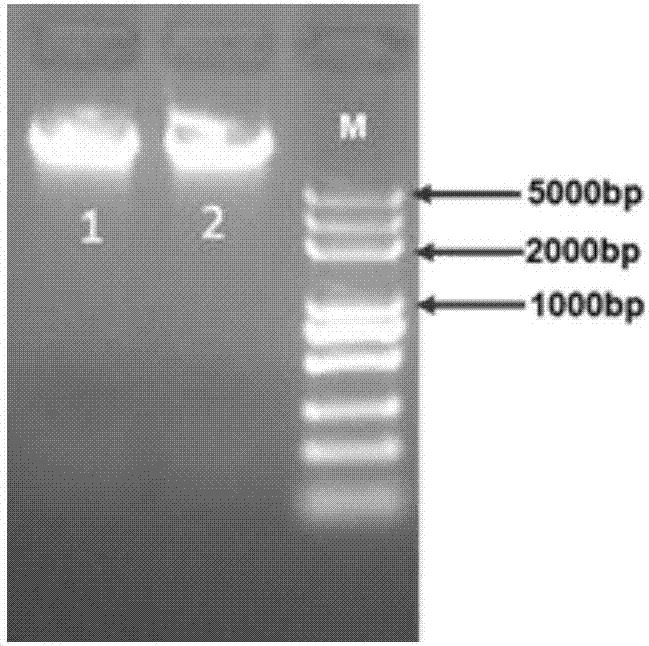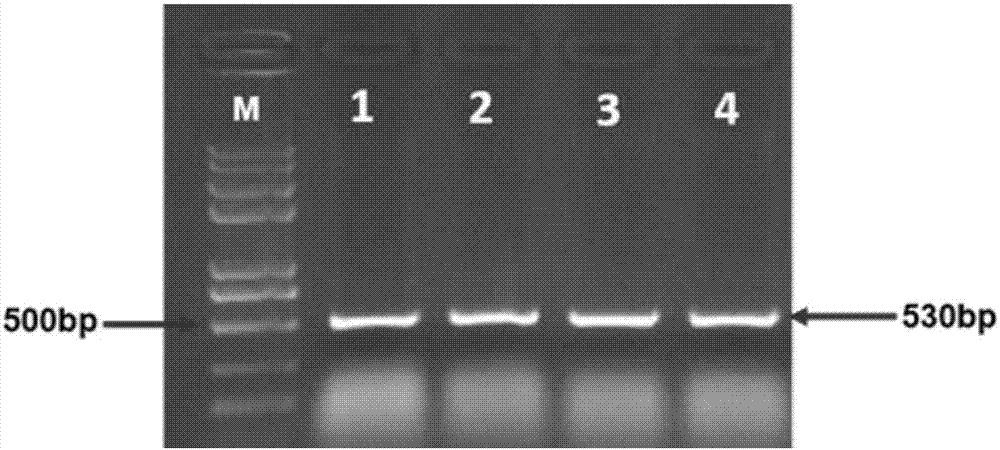Application of OsKTN80b gene in terms of reducing rice plant height
A rice and gene technology, applied in the fields of application, genetic engineering, plant gene improvement, etc., can solve the problems of unfavorable agronomic traits and difficult application, and achieve the effect of increasing planting density, good effect, and improving rice yield
- Summary
- Abstract
- Description
- Claims
- Application Information
AI Technical Summary
Problems solved by technology
Method used
Image
Examples
Embodiment 1
[0036] The construction of embodiment 1OsKTN80b CRISPR / Cas9 knockout vector
[0037] The inventor screened a small mutant material in the EMS mutagenesis mutant library of Shuhui 498 background, and obtained 5 candidate genes through whole genome resequencing and MutMap positioning analysis, including the microtubule splicing protein encoded in it The LOC_Os04g58130 gene of the p80 subunit OsKTN80b; the candidate gene OsKTN80b was knocked out by CRISPR / Cas9 gene editing, and the function of this gene in regulating the phenotype of rice plants was unexpectedly discovered.
[0038] A cas9 knockout vector was constructed using Baigegene CRISPR / Cas Vector Construction Kit.
[0039] (1) Target sequence design: sgRNA online design software website in CRISPR / Cas9 system: http: / / www.e-crisp.org / E-CRISP / designcrispr.html Input the OsKTN80b gene sequence (see SEQ ID NO.1), design and generate gRNA target sequences SG1 and SG2. The recognition sequence is 19bp, and the target sequenc...
Embodiment 2
[0058] Example 2: Transformation of rice with OsKTN80b cas9
[0059] (1) The two recombinant plasmids C1 and C2 obtained in Example 1 were respectively introduced into Agrobacterium strain EHA105 by freeze-thaw method. Mix each 100 μl of EHA105 competent cells with 0.5-1 μg (about 2 μl) of plasmid DNA, place on ice, liquid nitrogen and 37°C water bath for 5 minutes; dilute to 1ml with fresh LB liquid medium, shake at 28°C The bed was incubated for 2-4 hours; 200 μl was taken out and spread on an LB plate containing antibiotics Kan (50 μg / ml) and Rif (50 μg / ml), and incubated at 28° C. for 2-3 days. Pick a single colony of Agrobacterium from the LB plate and inoculate it into 3ml of LB liquid medium containing antibiotics, cultivate overnight on a shaker at 28°C, and transfer it to 50ml of LB liquid medium containing antibiotics the next day at 1% inoculum size. Continue shaking culture at 200rpm to OD 600 When it is about 0.6 to 0.8, centrifuge the fresh Agrobacterium broth ...
Embodiment 3
[0064] Example 3: Genomic DNA extraction of transgenic rice, PCR detection and sequencing of mutants
[0065] Proceed as follows:
[0066]The CTAB method was used to extract the genomic DNA of the transgenic rice leaves of the T0 generation obtained in Example 2; PCR sequencing analysis was performed on the knockout sites of the transgenic plants of the T0 generation. The PCR amplification system is: 10×buffer for KOD-Plus 2.5μl, KOD plus polymerase (5U / μl) 0.25μl, 25mmol / L MgSO4 1μl, dNTPs (2mmol / L) 2.5μl, each primer (10μmol / L , Cas9-p80-1F and Cas9-p80-1R) 0.5 μl, and (10 μmol / L, Cas9-p80-2F and Cas9-p80-2R) template DNA 0.5 μl, made up to 25 μl with ultrapure water. The reaction conditions were 94°C for 2min; 30 cycles of 94°C for 20s, 58°C for 30s, and 68°C for 60s; 68°C for 5min. The amplified product was subjected to 1% agarose gel electrophoresis (electrophoresis buffer 0.5×TBE), observed and photographed by the BIORAD gel imaging system (see image 3 and Figure 5...
PUM
 Login to View More
Login to View More Abstract
Description
Claims
Application Information
 Login to View More
Login to View More - R&D
- Intellectual Property
- Life Sciences
- Materials
- Tech Scout
- Unparalleled Data Quality
- Higher Quality Content
- 60% Fewer Hallucinations
Browse by: Latest US Patents, China's latest patents, Technical Efficacy Thesaurus, Application Domain, Technology Topic, Popular Technical Reports.
© 2025 PatSnap. All rights reserved.Legal|Privacy policy|Modern Slavery Act Transparency Statement|Sitemap|About US| Contact US: help@patsnap.com



